#sarazanmai fan art
Explore tagged Tumblr posts
Text

sara
397 notes
·
View notes
Text
MY FIANCÉ AND I MADE LIL SARAZANMAI PINS LET'S GOOOOO
I made the lil arts:


and he did the whole pin thing!:

With holographic hearts and all !!! I'm so happy about how they turned out ><
We are so NOT normal about this series and there's barely a fandom let alone merch so might aswell create it for ourselves !! I really wanna make a lot of pins and keychains and stickers and stuff and just fill an entire ita bag with them to carry my niche blorbos around
#sarazanmai#kazuki yasaka#kazuki#enta jinnai#enta#toi kuji#toi#reo niiboshi#reo#mabu akutsu#mabu#kappa#anime#manga#art#lineless art#fan merch#pins#comic
67 notes
·
View notes
Text
beneath the cut is an essay I've titled "Ikuhara Fandom, Shoujo Manga, and Eroticism." it discusses potentially upsetting subject matter.
when I first encountered RGU in 2014, I was largely baffled, though I thought the ending was very good. after that, I didn't rewatch more than an episode or two of the show again until 2020. Ikuhara was inaccessible to me as a teenager, but I spent years studying media, so when I returned to RGU, it was like discovering a goldmine. by the end of 2020, I'd watched all of Ikuhara's original shows.
the thing is, I still found Ikuhara challenging. there were things about his works which were seemingly contrary to my value system. I would read interviews of his and he would say things which sounded alarming--to use cliche terminology, he wasn't very politically correct.
if we're being honest, there is a party line in a lot of left-leaning fandom spaces. I used to be a part of that more than I am now; I had rigid ideas of right and wrong. today in the Ikuhara fandom, I often feel like the elephant in the room is that his works aren't the kind of "queer feminist masterpieces" that people portray them as. now, by that, I don't mean that those words don't apply to his works: what I mean is that the way people frame them, the way they discuss their meaning, doesn't bear that much relation to Ikuhara and his oevre.
RGU gets this treatment more than his other works. in fact, certain fans want to claim it as the work which truly aligns with their values, while Penguindrum, YKA, and Sarazanmai actively subvert RGU's message. a lot of other fans just stick with RGU, claiming it as a work without critiquing it. by critique, I don't mean negative criticism: I mean critique as in actual engagement with the text.
I remember that there was a point when I was afraid to engage with more Ikuhara interviews/works, since I thought I would find something out about him that made it so that I couldn't enjoy RGU. after all, when I would hang around in RGU spaces, every so often I'd see someone say that Ikuhara was super problematic. then I realized I was ignoring one of RGU's main themes, facing the truth rather than trying to stay in an idyllic past, so I took the dive. I had my ideas challenged, my values changed, and my entire approach to media shifted by doing so.
it's been strange to be in the English-speaking fandom, where everything is taken very seriously and there's certain universal assumptions about RGU's meaning, when many of the things held as absolutes are simply not so in the Japanese fandom. equally, the creative minds behind RGU are often in conflict with the Western fandom as well. once or twice, I've seen someone point this out and say that RGU is actually problematic/patriarchal, but mostly, it is ignored.
for instance, the character Ruka is massively hated in the western fandom, while as far as I understand, Juri/Ruka is one of the most common Japanese doujin pairings. Mamoru Hosoda, who storyboarded many Juri episodes, claimed that Ruka was in love with Juri. turning to Ikuhara, he often phrases things in a way that could leave you wondering if he's as much of a "feminist ally" as people want to paint him as. of the women's liberation movement, Ikuhara said, "On the one hand you had this social movement, but then in their heads I think almost everyone was thinking: this is lame (laugh), I don't wanna do this (laugh)."
consider this exchange from the same interview for a demonstration of just how differently people in the western fandom approach media compared to Ikuhara and a contemporary of his, art critic Mari Kotani:
Ikuhara: Speaking of sexuality, after Utena I wrote a novel which features lots of hermaphroditic characters. It's a collaborative work, a book called Schell Bullet. Kotani: It is a fantasy world? Ikuhara: It's a future world. Humanity has divided into roughly two groups, Majors and Minors. Because of gene manipulation the Majors are hermaphrodites without male/female sexes, and they have a monopoly on good genetic material. The Minors are humans who have fallen away from the monopolized gene material, they look basically the same are present-day humans, and have two sexes. Kotani: Sounds interesting! Are the Minors kind of like slaves, like in The Human Livestock Yapū?
later:
Ikuhara: The boss is visually female, a Major with a very bold beauty. From the start I wanted the main character's boss to be a hermaphroditic woman. That's because, the way I see it, even the Major women in the real world, that is to say women who are competent workers, seem to have an intense male side.
what I find most interesting in this exchange is how Kotani casually brings up the idea of sexual slavery as a fun angle for Ikuhara's hermaphrodite novel. it's not to say that this kind of attitude is universal in Japan, just as leftist fandom spaces aren't universal here in America. however, there is obviously a huge difference in values between these two worlds.
so, what world is Ikuhara occupying? where did he come from and what are his influences? exploring these questions is what helped me to come to peace with his works, and in the process, I changed my own thinking.
I'm not really qualified to speak in depth on Japan, its history, culture, or values. however, I have looked into specific trends which I know were influences on Ikuhara specifically, so that's what I'll focus on here.
Ikuhara was born in 1964 and became a teenager in the 1970s. it was a period marked by a lot of social movements. he describes in many interviews feeling completely disillusioned when, rather than change society, the movements were crushed or simply collapsed in on themselves. "oh, maybe there's no way to change the world after all." however, one way or another, he seems to have pulled himself out of that despair. his works are all designed to give modern people a way out of the end of history brought on by the failure of radical change and the onset of the neoliberal global order.
as a young creative, he was into the dramatist/director Shuji Terayama and other artists who were pushing boundaries. in the Kotani interview, he stated:
Ikuhara: Terayama's words are interesting too, but what I find the most kitschy and cool is his theatre. Suddenly a completely naked actress would appear, without even a genital cover, and this was in Kinokuniya Hall! The police might barge in saying "Hey, wait a second". I guess this is why they say it's a fine line between a hero and a criminal (laugh), but until then I had never thought that showing your panties or showing your willy could be anything but shamelessness, and now the Asahi Shimbun was treating it as superb culture. I found that gap extremely mysterious and fascinating, and personally I felt a cultural nuance there.
clearly, the libertine values of 20th century countercultures left their mark on him. more than that, he is interested in the conflict between sexual repression and sexual expression, which has only escalated in Japan and in the West up until today.
turning to the anime/manga sphere, I know that RGU has a reputation as being very triggering, but to be honest, compared to its predecessors, RGU is mild and restrained. J.A. Seazer, a musician who Tereyama collaborated with, wrote songs for both RGU and the the 1992 anime film Midori. the story is old, dating back to the beginning of the 20th century, and it's been adapted as recently as 2016. Midori is an exploitation film: full of child rape, set in a freak show, featuring countless horrors in its 40-minute run. I've watched it and would not recommend it unless you're interested in the ero guro genre.
I bring up Midori as an example of the media landscape Ikuhara began his career in. he was working on Sailor Moon, so obviously, there was less heavy content in the world of anime and manga, but Sailor Moon is represents only one side of shoujo. Ikuhara is more aligned with the Year 24 Group, who revolutionized shoujo in the 1970s. the group produced a wide range of works, many of which had obvious influences on Ikuhara.
I know that Ikuhara is often associated with lesbians, but in fact, I would say that shoujo BL is one of his largest anime/manga influences. the early work Kaze to Ki no Uta is an acknowledged influence on RGU, and Ikuhara did an interview with its mangaka, Takemiya Keiko.
many of the early BL mangaka were inspired by western literature. Demian is not only referenced in RGU but also in Kaze to Ki no Uta. most important for BL is the 1912 German novel Death in Venice, as well as its 1971 film adaptation. for those unfamiliar, the novel is about a man in his 50s stalking a young teenage boy, becoming completely obsessed with him and other underage kids. it is a sexual obsession, but there are other angles to it, and the story has been analyzed in various ways. the fascination seen in shoujo and BL with beautiful young boys, as well as pedophilia, can be in part traced back to this story.
taking inspiration from Death in Venice, shoujo's fundamental character dynamic was established, one that can also be seen in a film such as Midori: innocence versus experience. the ever-present theme is corruption, how abuse and exploitation corrode personalities and create societal damage.
how this is handled can vary from work to work. I understand that grotesque depictions of child abuse or failure to condemn pedophilia hard enough make some people not want to engage with these works at all. I will say, whatever one thinks of Death in Venice, Kaze to Ki no Uta, along with the BL manga of Takemiya's contemporary Moto Hagio, are certainly not child porn. I think there is no excuse for CP, and even if there are things in Kaze to Ki no Uta that I question, it is overall a work of artistic merit, beyond holding interest to me as an early work in the genre.
as I've said, RGU is mild compared to much of what came before it, as well as a contemporary manga like A Cruel God Reigns. however, the core of its character dynamics are in line with shoujo/BL. the twist is that the work focuses on relationships between women.
Kotani: ...Watching it, the relationships between women, including the dialogue, were very sexual, very vivid, right? Ikuhara: But I think what it is expressing is simply yaoi. To do that using shōjo "royal road"-like characters, and with two women, is somewhat rare I think.
Utena and Anthy are easy to compare to BL couples who came before them, like Serge and Gilbert or Ash and Eiji. rather than approach gender issues through projection on to pretty boys, Be-Papas chose to use women, creating their own version of a gendered social system. of course, other Year 24 Group members used lesbians or GNC women to explore similar themes, with Rose of Versailles being another major influence on RGU. however, Ikuhara claiming that RGU is essentially yaoi has fascinated me for years.
Anthy and Akio are experience, knowledge, and corruption, while Utena is innocence, youth, and purity. like many predatory shoujo characters, Akio is obsessed with innocence and purity while also seeking to destroy them. the drama centers on Utena's struggle with corruption, as well as Anthy's conflicted feelings towards her friend's naivety, as she both identifies her past self with Utena and resents her for her ignorance. the story also features intense power dynamics, which, over the course of the narrative, are upset. all of these elements are standard for BL and shoujo.
to dig deeper into the value sense behind these works, here is a passage from the Takemiya/Ikuhara interview:
Takemiya: What I wanted to ask is about “crossing the line” for a girl [implicitly losing one's virginity/sexual purity]. I thought Utena crossed it unexpectedly easily. Ikuhara: Ah, I’m not thinking very deeply, right? Actually, I just wanted to suggest that it doesn’t matter. Because a lot of people seem to get caught up in issues of purity, I wanted to show that it didn’t matter. Takemiya: But doesn’t it seem like more kids these days don’t care about those things? Ikuhara: Yes, and that’s another reason I did it. But I think there are still many people who would try to put it in a box and say purity is important because it is an animation. Takemiya: Actually I think it’s more likely a lot of people will try to use the purity as an index of understanding. I guess you are an adult if you can overcome that. Ikuhara: That’s true, there are a lot of people that want to put a line between justice and absolute evil based on purity. I didn’t want them to do that. Whether manga or anime, I think it can become a motivation for the viewers and the readers in real life. I don’t like when people draw lines, out in society, equating absolute evil with impurity - in an animation which is nothing more than fiction, drawing a line between those that are carnally pure and those that are not.
I think we can all agree that Akio was in the wrong for trying to make Utena feel guilty for sleeping with him in episode 38 of RGU. but going further, Ikuhara and Takemiya say that they want to reject purity as an index of understanding altogether. to me, what this means is not jumping to immediate judgments, not treating issues of sexuality as if they are so deep as to sully the soul.
this is NOT to make some kind of excuse for pedophilia or child porn. I know from my own life how harmful those things are. to close out this discussion, I am going to try to explain what I mean by touching on the use of eroticism in art.
years ago, I was watching Naoki Urasawa's Manben, a show which gives space to mangaka to show off their process. Junji Ito went on it, and I was troubled by the following moment from the episode:
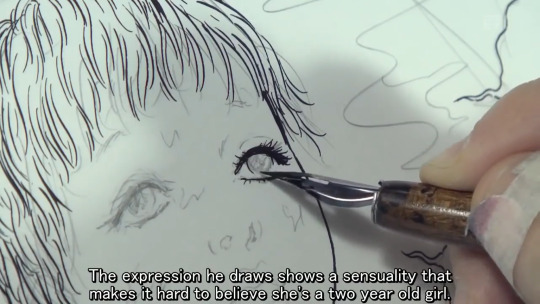

before I got into Ikuhara, I didn't have a grasp on the erotic. when I watched this, my thought was, why are they talking about a toddler being erotic?
after having gained an appreciation for eros's place in art, I understand what they were saying here. eros is hard to define, but it relates to sensuality: a way of interacting with the world which is beyond the intellect. the erotic is not pornographic: it is evocative, a way to make any work of art touch its audience on a deeper level. it is related to sexuality but is not the same thing as it. for Ito, exaggerating the erotic aspect of this character helps him to create even greater horror. the point is not to make a toddler sexy.
RGU relies heavily on this kind of eroticism for different purposes, both within the series and in the promotional art. whenever I see someone trying to ban a specific kind of fan art, I roll my eyes for this very reason. it's not as if there's any significant numbers of people making RGU exploitation porn or anything; most of it is in line with the show itself. for instance:

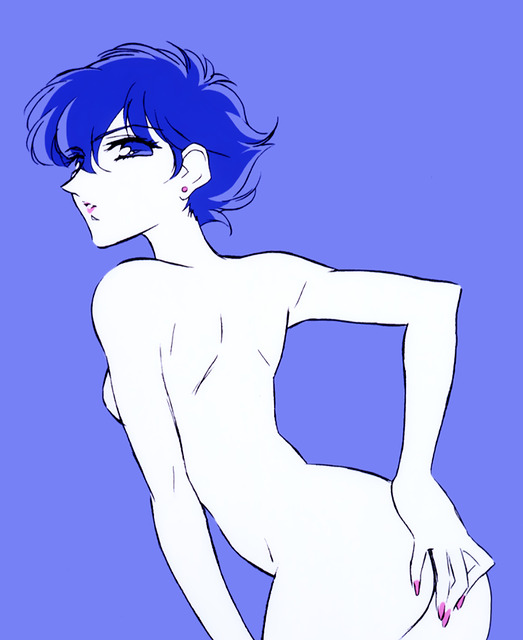
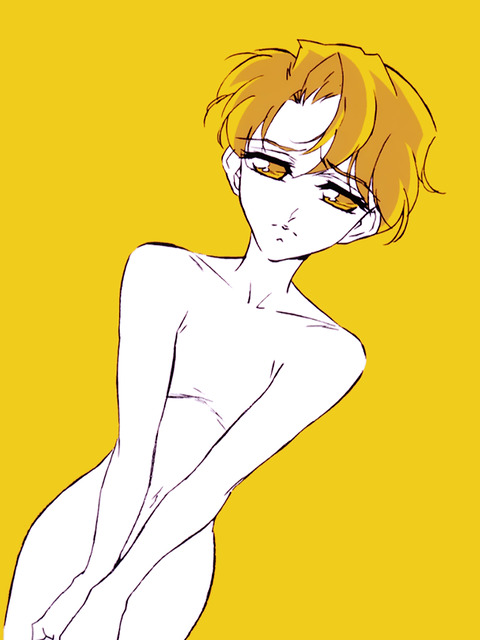
official art of characters all 13 and younger
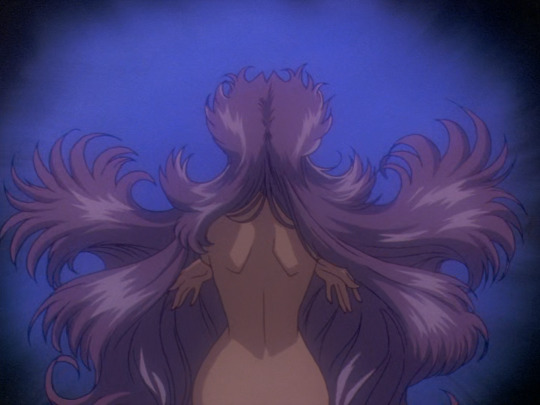
Anthy having sex with her brother in the series proper (episode 31)
I have seen RGU called exploitative and fetishized, though not as often as I've seen the same criticism leveled at later Ikuhara works. however, more often than not, the disturbing eroticism of RGU is left uncommented on.
to come full circle, the reason that I now have a lot of admiration for Ikuhara is that I've come to see that the "problematic" aspects of his work help him to tell meaningful stories. all of his anime are designed to spark self-revelation/self-transformation in their audiences. additionally, I now appreciate erotics for what they are, feeling them on the sensual level rather than intellectualizing about them. viewing the above images, various readings can be drawn, arguments made about the impact of their eroticism on the themes they express. however, there is a more primal appeal to them, something which draws the eye. that aesthetic quality, by itself, deserves to be defended. those who dislike it should probably not engage with Ikuhara works. from RGU commentary, episode 38:
Hideki Mori: Are you always trying to work in this type of erotic undertone? Ikuhara: Yes, well... if it doesn't have that kind of stuff... it's not very interesting! Either I'm doing it to make it interesting or maybe I just wanted to see that.
I will finish with two final points. firstly, I think that letting go of one's automatic response of moral judgment is essential when approaching Ikuhara anime. this is not the same thing as advocating for a laissez-faire, anything-goes approach; it is simply saying, before applying preconcieved notions, let the work's textual, aesthetic, erotic, and sensual levels wash over you. if you give the work time and find some aspect of it offensive, that's one thing, but I am glad that I didn't let my kneejerk reactions turn me off of Ikuhara. along with that, don't immediately apply some kind of feminist, queer, or leftist lens to explain everything either. just let the work breathe.
lastly, I want to share Ikuhara's words on what affect he thought RGU had on its audience:
Ikuhara: I didn’t want 'Utena' to become a nice story. A story can be pretty, but it feels like a lie. From the beginning, the story was going to be about saving a friend, so in that sense that was the goal, but it can easily become a nice story, so to break away from that I made sure that it was a foolish story. I think it’s this foolishness that makes ‘Utena’ so popular with adults. Not in a sexual way, but more that watching it at that point makes it more relatable.
to re-emphasize, my point with this discussion was that much of Ikuhara's artistry is ignored because his approach and influences are considered problematic. that being said, it was never his intention to make a work about "sexy teenagers" who adult viewers can masturbate over. none of his works are that: they feature students because anime often features students, and because he has an interest in the threshold between childhood and adulthood. although I am now 26, I can see myself in all of his casts, and the eroticization of the art makes me more invested in the story and themes, not titillated.
88 notes
·
View notes
Text
Animation Night 155: Kunihiko Ikuhara
...or Ikuni to his fans. The Utena guy.

Since the very beginning of this series, Ikuhara’s been someone I’ve been desperate to cover. He’s exactly the kind of weirdo we like around here. And you know how much the Tumblr girlies love Utena.
But only now, at Animation Night 155, is Ikuni getting his due. Why so long? Well, let’s put it like this. Ikuni’s very much a TV guy. Revolutionary Girl Utena is 39 episodes and a movie. Mawaru Penguindrum: 26 episodes. Yurikuma Arashi is 13, as is Sarazanmai.
And if we’ve managed to cram in 13-episode series into this format, it’s always been with difficulty - take Heike Monogatari [AN91], Alexander Senki [AN125] or Houseki no Kuni [AN97]. It generally takes multiple nights. So I thought, that’s fine, we’ll do Adolescence of Utena, the movie, and, um... hmm.
Luckily for us they just made a new Penguindrum compilation movie! Problem solved let’s go!
And with such a long wait behind us, let’s try and do the guy some justice.
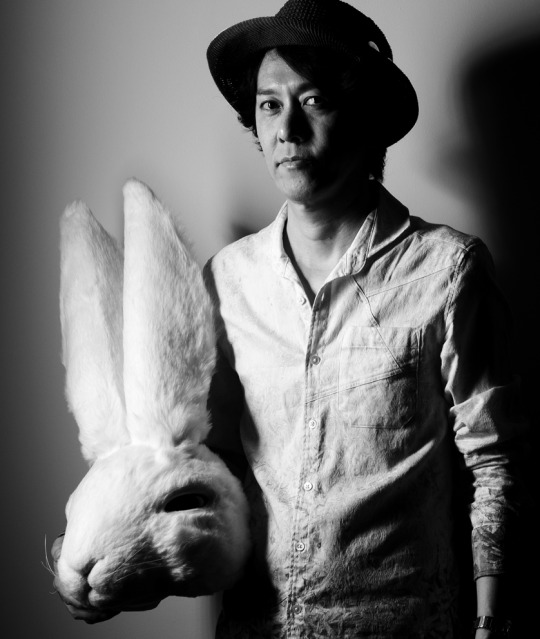
So. Who is this guy with the rabbit? (Picture from his website. Though this is a plain outfit by Ikuhara standards!)
If you were trying to summarise Ikuni’s works... you could probably say something like this: surreal, densely symbolic stories about the difficulties of real human connection. Sort of like the anime version of Lynch. But if that sounds too cerebral, let’s not forget that an episode of Utena involves a character gradually turning into a cow for no particular reason. He’s just as much a goofball who loves to tell lies.
Ikuni came into the business back in the mid eighties, at Toei. [c.f. AN149 for a brief history of Toei!]
So. In the late 70s, Toei had established a powerful niche to themselves in long-running, wildly popular series such as Galaxy Express 999, but most of their work was much less high-profile. Take a glance, see how many of these you recognise - I would guess not many! Hot out of art school, Ikuhara became an assistant director under the wing of Junichi Satō, later well known for shōjo anime such as the avant-garde Princess Tutu (2002-3), or Ojamajo Doremi (1999-2000).
But of course, the most renowned Satō project is Bishōjo Senshi Sailor Moon (1991-7, Pretty Soldier Sailor Moon). Satō directed the first half, and then Ikuhara took the reins for the rest. For Satō it was his debut as a director, I’ll talk more about his tenure on Sailor Moon in just a minute, but first, let’s get a little context about... magical girls!
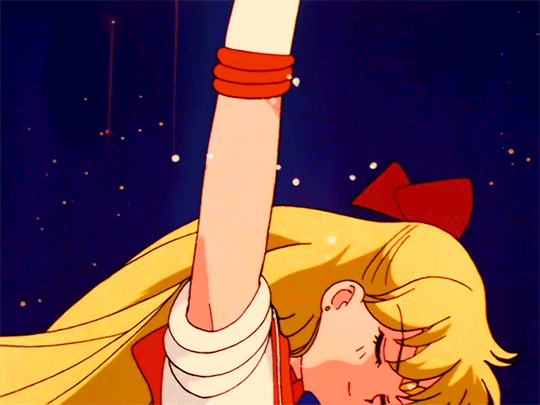
(quick! tell me which sailor this is! you have five seconds)
Magical Girls! 魔法少女 mahō shōjo. An ordinary high school student makes contact with a powerful magical being, who may also be a cute mascot character, and agrees to help. Now she can transform: manifest a stylish outfit, gain suitably themed powers, and fight monsters of the week... but she’s got to maintain a double life as a regular student. The henshin (transformation) sequence itself will usually be an extremely elaborate sequence that is played regularly (a ‘bank’ shot).
By now it’s one of the absolutely central anime archetypes, one people are likely to recognise even if they’ve never watched a magical girl show. It’s been parodied, it’s been genderflipped, it’s spun off a dark otaku-oriented variant.
But it wasn’t always so! Everything must begin somewhere. Very quickly reeling this off then... Osamu Tezuka’s 1953 manga Princess Knight is seen as the earliest proto-magical-girl work; Himitsu no Akko-chan (1962-5) as the earliest true magical girl manga with the elements of the genre, and 1966′s Sally the Witch as the big populariser. In the 70s, Toei started producing them in a big way, known collectively as 魔女っ子 majokko series (‘little witch’).
The actual phrase 魔法少女 mahō shōjo was introduced in 1980 with 魔法少女ララベル Mahō Shōjo Lalabel. With the economic bubble in full swing, other studios started to join the party - notably AshiPro with Minky Momo, and Pierrot, the studio behind epoch-defining megahit Urusei Yatsura, who entered the arena with Creamy Mami, the Magic Angel (1983-4). Why is she creamy? I don’t know, but that’s her stage name as an idol; the manga was designed to promote an actual idol singer Takako Ōta. This business model proved wildly successful, and even today anime production committees usually include record companies who use the show as a vehicle to promote a song or group. Toei no longer had exclusive hold on the matter of girls, magical.
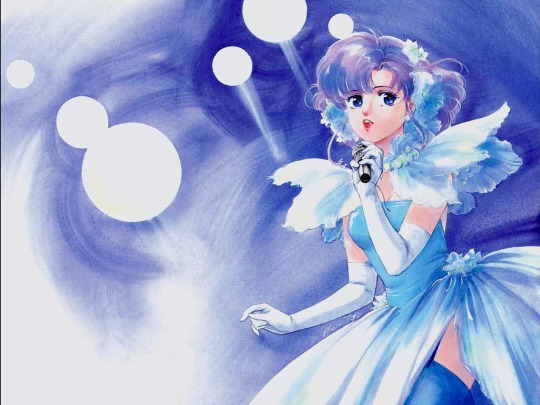
Visually here we’re seeing 80s-style bishōjo, the same as over the fence in sci-fi series such as Macross. Mostly the stories are comedies, following in the footsteps of Urusei Yatsura.
What was missing from the formula at this point? Surprisingly, the henshin sequences! It’s not that magical girls didn’t transform, but they would be more likely to transform into something like an aged-up version of themselves, and the act of transformation wouldn’t be given the same importance. This final ingredient was to be found over in tokusatsu land - Kamen Rider and Super Sentai.
So, that’s where Sailor Moon came in at the beginning of the 90s - first a wildly successful manga by Naoko Takeuchi, and in very short order a TV series at Toei. Takeuchi came up with the idea of fusing the magical girls with sentai: instead of a motorbike-like Rider suit, the girls would get sailor fuku. And that means every magical girl transformation is in a sense a homage to this one.
youtube
Sailor Moon tells the story of a girl called Usagi. She’s a clumsy and forgetful audience-identification character - perhaps even to point of being a Huineng-type character? - but she’s informed by a talking cat that she’s the guardian of Earth, soon to be joined by a number of other girls from her area who are, collectively, the Sailor Guardians (セーラー戦士 sērā senshi). To fight, she activates a magical brooch and, that ^ happens.
Why? Well, the Dark Kingdom is invading! They want to free the villainous Queen Metaria. In past lives the Sailor Guardians fought those guys, and now they need to get back on the job. The forces of the Dark Kingdom (and numerous subsequent enemy factions) arrive in the form of a series of themed villains, much like the villains in a tokusatsu show. Outside of fighting those guys, it’s gentle comedy with a large cast, not so far from the works of Rumiko Takahashi. In fact it’s apparently a fair bit more comedic in tone than the manga, and a chunk of that can be credited to Ikuhara’s influence.
It’s hard to try and summarise the 90s for anime, it wasn’t just one thing. Even as the economic bubble popped, the movies got increasingly ambitious, reaching for more complex emotions and darker themes with incredibly complex animation to match. And to a certain extent, that was also true on TV, by which I mean “Evangelion happened”. But it was also an age of a return to more limited animation. If you wanted to make a TV anime, you had to be smart about using all the tools you could to cut corners. You could keep a bank of reused shots, or for a joke, transform a character into a much simpler caricatured design with more limited animation. At the same time, photography was getting more advanced, and animation techniques were getting more sophisticated.
Even so, a lot of the credit for the art of working effectively in limited animation goes way back to Osamu Dezaki, who back in the 60s and 70s established many of the iconic ‘anime’ techniques. I’ve written about him before back on Animation Night 95, but as much as that covers the history, it doesn’t say a lot about Dezaki’s style. So let me pull in this video, which will helpfully illustrate the important examples...
youtube
The relevant period is when Dezaki directed on Aim for the Ace! (エースをねらえ! Ēsu o Nerae!) - where, in contrast to his earlier work which was comparatively cinematic, he started to push in a more theatrical, abstracted direction, prioritising conveying emotion over realism. Still frames (with the famous ‘postcard memory’ effect), simplified background details framed to draw attention to the important stuff, repeating an important shot multiple times - oh, that’s just Utena, huh? And while Dezaki influenced just about everyone, but for Ikuhara, he’s a massive touchpoint.
Designs were also changing - in contrast to the rounded bishōjo of the 80s came more angular and blocky designs. Take Slayers for example:

Hold onto that thought because we’re going to talk about Utena in a minute. Sailor Moon didn’t go quite that far, but Kazuko Tadano’s designs were very effective in conveying a lot of appeal in quite simple shapes. Usagi in particular has an instantly recognisable hairstyle. But it’s also a style very amenable to simplification.
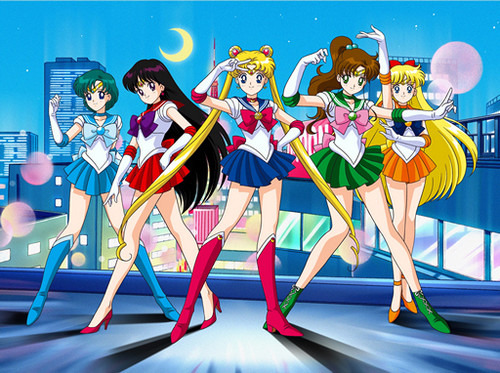
TV anime in this period ran long. Nowadays, the norm is one cours (‘cour’ if you’re not feeling pedantic) of 12-13 episodes, sometimes not even that. Back then you could easily see counts in the 50s or even hundreds. Such is true of Sailor Moon: crazy popular in both Japan and, in its heavily localised dub, America, and with a premise flexible enough to run for years. In the end it racked up some 200 episodes and several movies.
The Ikuhara period starts with the Sailor Moon R movie in 1993, then the series proper starting mid Sailor Moon R and then Sailor Moon S in 1994. Not sure which episode he took over, but S begins at 90. This is a post about Ikuhara (no, really!) so we should ask, how did Sailor Moon change once he took the reins? Let’s have a look at some of his favourite themes, as they appear in the Sailor Moon R movie, based on his own notes...
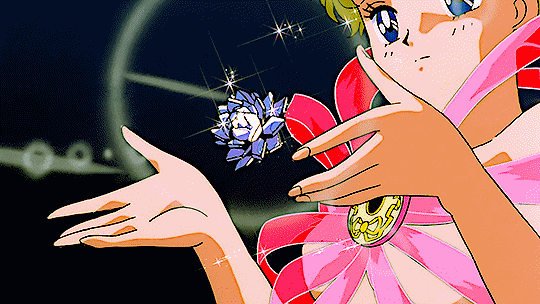
Lesbians - Not so much in the R movie, but once S gets going... big controversy! Sailors Uranus and Neptune were a couple whose dynamic was one of the most popular in the show, but this would be heavily censored in nearly every localisation, notably the American one which made them cousins.
Flower imagery - Ikuhara decided to set his first project as director in a botanical garden, naturally.
Lost connections, the distance between people - to quote the linked blog...
Ikuhara compares the reunion between Fiore and Mamoru with that of being stuck on a train in-between stations when suddenly you notice you’re standing next to an old friend you haven’t seen in years.
At first you’re both excited to see each other again and kill the time by catching up on each other’s lives. But eventually you run out of things to say, and the conversation just kind of dies off, leaving you both standing there in awkward silence.
Creative editing, use of music - 18 second long scene of Tuxedo Mask getting stabbed? Musically timed fight? Mm.
Darker themes - let’s watch the girls incinerate a field of flower monsters! At one point Usagi would nearly die! Ikuhara tried to keep it ‘fun’ and lighthearted, but just couldn’t do it, he says. Nothing on the level of where his later work would go, but definitely harsher than your average episode.
Vaguely hinting that some element is key to understanding everything, and then refusing to elaborate further - oh yes.
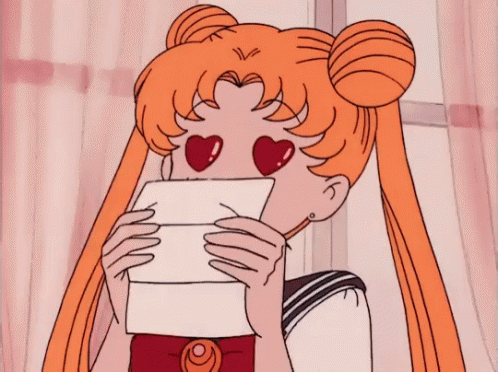
Which isn’t to say that Ikuhara’s Sailor Moon instantly became Utena. Rather, the seeds of his interests as a director, the sort of emotional arcs he’d like to portray, were there. I regret that I can’t really comment in much detail on what Ikuhara did in his actual run on the TV series - I’m sure I have some big Sailor Moon fans here who could fill me in and tell me if I’ve described anything wrong.
Working on Sailor Moon, in any case, also got Ikuhara used to technical elements that would become part of his stylistic fingerprint. We mentioned the transformation sequence, the elaborate bank shot with accompanying music that would recur in nearly every episode. I am less sure about other Dezaki-esque elements, like jokes based on repeating the same sequence with minor variations.
Eventually, Ikuhara’s run on Sailor Moon would come to an end. The final arc of the show saw the Sailor Guardians facing... themselves, from a distant bad future. But for that final season, Ikuhara had already stepped down. Where did he go...?
You see, Ikuhara chafed under the creative restrictions placed on him by Toei. Turning down an offer from Anno to work on Eva(!), he set off to found his own group, Be-Papas, along with...
the famous shōjo manga artist Chiho Saito, animator Shinya Hasegawa, writer Yōji Enokido, and producer Yuuichiro Okuro
and before long also recruiting composer J.A. Seazer, known for his work with avant-garde dramatist-filmmaker-writer-poet Shūji Terayama - another big influence on Ikuni, incidentally. What did Be-Papas make? Just one anime, after which they disbanded. That anime was... Albert Ei-
youtube
That anime was Utena.
Oh man. This is the one.
少女革命ウテナ - Shōjo Kakumei Utena. In English, Revolutionary Girl Utena. Now the time has finally come to write about it, I’m nervous. Could I possibly do justice to Utena in a single blog post? Is that why I spent so long writing about Sailor Moon?
Let’s start with the aesthetic: French Revolution-esque outfits that would be comfortable in Rose of Versailles. A school made of white stone; architecture that is strange, avant-garde. Roses. So many roses oh my fucking god. It draws heavily on the Takarazuka Revue, which I wrote about previously on Animation Night 92 in the context of Ikuhara’s protege Tomohiro Furukawa.
Utena is about a girl called (wait for it) Utena, who attends a school of sorts called Ohtori Academy. But it’s a school only in a fairly abstract sense - it’s more like a palace. She wears a distinctive masculine uniform, and shortly after transferring in, discovers a mysterious underground duelling society who go to a strange abstract battle arena outside of school hours. There, they attempt to strike the rose from the other duellist. The winner of the duel gains custody of Anthy Himemiya, the ‘Rose Bride’. At some point, whoever possesses Anthy will gain the nebulous power to ‘revolutionise the world’. With me so far?

Utena walks in and immediately wins her first duel, establishing an initially frosty relationship with Anthy. But the White Rose duellists won’t take this lying down. Over the first series of episodes, we learn about each of the duellists and their motivating conflicts, culminating in an attempt to defeat Utena. (She walks up the stairs every time.) They lose every time, but the point isn’t really about whether Utena will win or not - it’s about introducing us to a collection of fucked up guys, and then making them even more fucked up.
But it’s not all high drama. A lot of Utena is just straight-up antics, which is to say, just about any time Nanami is on the screen. There’s a greek chorus of shadow girls who comment on the events of the episode. The broad strokes are hard to miss, but the subtler, more obtuse stuff is the sort of thing that can get you into an almost endless rabbit hole of analysis. Don’t take things too literally! You could probably call it at least a little Brechtian in how much it foregrounds its own artifice.
After Utena’s defeated just about everyone at the White Rose, the Black Rose arc introduces a new element. Now, characters from beyond the duelling circle will go down an elevator to guy who renders a fucked up sort of anti-therapy which will motivate them give into their worst impulses and have a go at Utena. Utena, meanwhile, is harbouring a complex where she needs to live up to an ideal of fairytale prince following an incident from her childhood - and oblivious to what’s actually going on with Anthy.
Then at last Anthy’s brother Akio shows up - the actual prince from the upside-down castle in the sky that represents the power to revolutionise the world, and the architect of the monstrous system. It turns out he’s been incesting Anthy, that she’s complicit in all his shenanigans (guess who was behind the Black Rose thing). Moreover, Utena is pulled in to Akio’s orbit, an ugly, abusive relationship... that is conveyed mostly through visual metaphors involving cars.
The finale is... complicated to explain. But it gives us one of the most iconic pieces of cinematic lesbianism ever animated, as Utena reaches for Anthy, refusing to be pushed away (by stabbing) or let Anthy remain in her state of self-inflicted pain, and they are able to escape the academy and its system, at the cost of being separated. What future they have outside the academy is left unspoken...
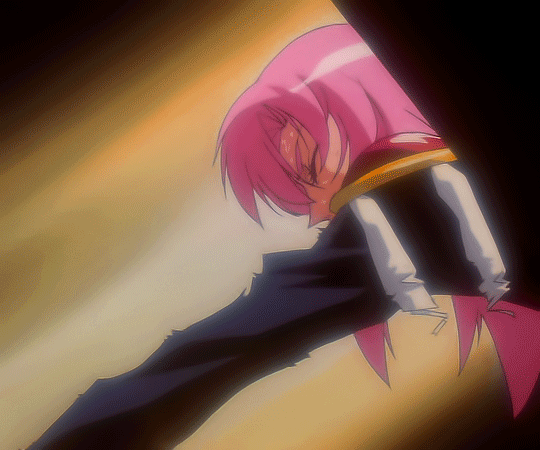
And that’s just scratching the surface. If you ask the hardcore Utena fan, just about every element of every shot is dripping with meaning. You can’t take everything too literally, but you definitely have to take some portion of it literally or you don’t have a story and characters at all.
Visually, the characters in Utena are designed by Shinya Hasegawa - and as much as they are recognisably ‘90s’, they really push it. People are long and faces - noses and chins especially - are pointy. Characters tend to be reserved and stoic in their facial expressions, unless they’re Nanami, in which case all bets are off. Animation-wise, JC Staff did the work under Be-Papas’s direction - and as much as it uses limited animation for effect, it’s really got the goods, especially in the duel sequences and the bank shots (Utena climbing the stairs? Not CG!).
Did you know Yoh Yoshinari was on it? I didn’t until today! So too was Mamoru Hosoda.
Remarkably for such a deliberately challenging show Utena was pretty successful! This was the era between Eva and Lain: it was an excellent time to be making something really experimental and push those genre boundaries. (One thing I don’t really know is how Utena got funded in the first place, but all the big names attached to the project probably gave them some pull.)
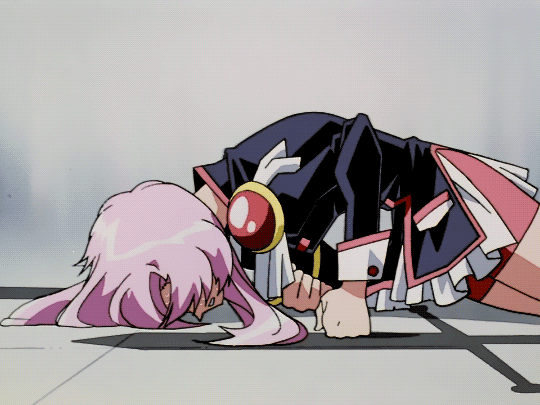
Alongside the anime came a manga by Saito - but neither is really an adaptation of the other, they’re just two different interpretations of the same general concept and premise, produced at the same time. And in fact, Ikuhara and Saito clashed heavily over the direction of the series, particularly in regards to whether the relationship between Utena and Anthy should be presented as romantic. Saito did not believe that shōjo audiences would be on board with the yuri, but Ikuhara refused to back down. (Saito eventually changed her mind.)
With all this success, they went ahead to make a movie. Now, usually a compilation movie of a successful TV series will cut out down the story to fit the runtime, reanimate a few scenes and call it a day. But this would be all but impossible with Utena, which is so tied to its episodic structure and use of repetition. And in any case, Be-Papas had bigger ambitions!
The film would be titled 少女革命ウテナ アドゥレセンス黙示録 Shōjo Kakumei Utena: Aduresensu Mokushiroku, literally Revolutionary Girl Utena: Adolescence Apocalypse, though in English it’s usually given the shorter title Adolescence of Utena. It is kinda sorta a condensed version of the series at first... and then in the latter half it goes completely off the rails. This time Akio is long dead. And he’s not the only one! It ends with this absolutely nuts sequence where Utena turns into a car to drive Anthy out of the academy, pursued by Shiori, who also turns into a car. I still can’t say I really understand it, or how it relates to the ‘car is a rape metaphor’ role in the TV series? But it looks beautiful.
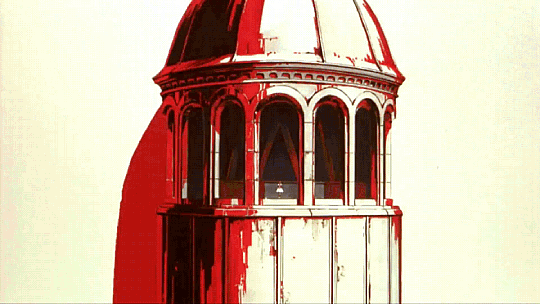
Compared to the series, the movie features the expected higher drawing counts and flashier animation... but the really novel aspect is the architecture. This movie goes absolutely wild with it: the Ohtori Academy this time is far stranger and more intricate, looking less like a regular old European palace and more like something dreamed up by the Russian avant-garde.
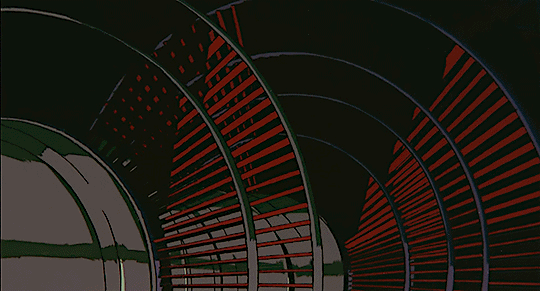
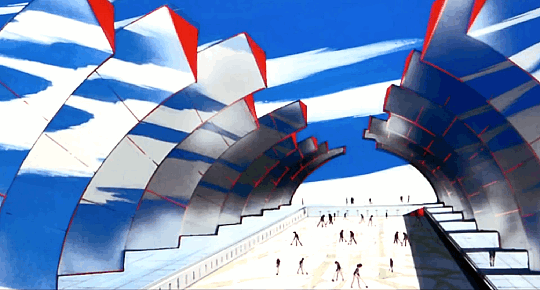

It’s less of a summary of Utena and more of a companion piece. Seen on its own by someone who’s not familiar with either... I’m not sure how it would come across! Maybe you’ll just think I’m insane. Maybe you’ll be right.
So, some 3000 words into this post, I’ve finally told you the first movie we’ll be watching! That’s right: we’re going to jump in at the deep end and enjoy Adolescence of Utena. You don’t need to have seen the series.
After Adolescence, Be-Papas disbanded, as if following Monsieur Dupont’s injunction that radical groups must exist for a single purpose and then disband. Ikuhara left anime for a long time, like twelve years. He wasn’t entirely cut out from the industry, occasionally dropping in to storyboard an episode or two (for example, Episode 2 of Diebuster, or the OP to yuri series Aoi Hana). But for the most part, he turned his attentions to other mediums.
In that time he published a shōjo manga, which was poorly received for being a lot more conventional than Utena; he also wrote a novel called Schell Bullet which, get a load of this...
As a result of gene manipulation, society is segregated by genes into "Majors" – intersex humans who maintain a monopoly on stronger genetic material – and lesser dual-sex "Minors". (Ikuhara stated that he chose to make the Majors intersex because he wished to create "a race which combines the good parts of both women and men."[1]) Protagonist Ors Break is hired by the intergalactic trading company Balt Liner Corporation to pilot a schell, a bio-organic mecha, by claiming to be a Major. When the truth of his Minor status is revealed, he comes to an agreement with his superior, a Major named Delbee Ibus, to continue working for the organization.[1][2]
...and another serial novel called Nokomono to Hanayome, described as ‘Lolita hardboiled’ (I believe as in ‘Elegant Gothic’ rather than as in ‘Nabokov’s novel’). This last was a precursor to Penguindrum - animal costumes, the a story about the 1995 Tokyo sarin gas attacks.
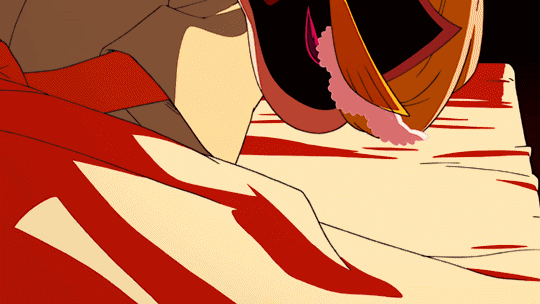
In 2011, Ikuhara came back to anime. Why? And why did he leave in the first place? itsamystery.jpg. In any case, his new project was... Mawaru Penguindrum. It’s about, I guess you might say, the abandoned children of cultists who connect to a supernatural penguin being through a hat. But honestly it’s even tougher to attempt to summarise than Utena. There’s a “child broiler” involved. That’s just the start. And this post is already very long.
So, it’s time to split it. You’ll be able to read more about Penguindrum tomorrow (or later today, if you’re also staying up insanely late in the UK).
Animation Night 155, in its cosy new Sunday timeslot, will be running (if all goes according to plan) at 8pm UK time. That’s about 13 hours from the time of this post. The plan will be to watch Adolescence of Utena and the two movies of Re:cyle of the Penguindrum, for a total of about five and a half hours. (Sorry Sailor Moon fans! I’d really like to squeeze in the R movie too, but I underestimate how long Penguindrum is in movie form. We’ll find another day to do Sailor Moon though!)
If you’ve read all this so far, thanks so much! I’ve wanted to do a proper Animation Night on Ikuhara for ages, and there’s so much I can write about. So far it’s all history, but we wanna do some analysis too. For now... hold on tight.
97 notes
·
View notes
Note
unrelated to prompt suggestions but. anime/manga recommendations? i don’t really care about genre just throw anime/manga u like/recommend at me lmao
i feel like im a pretty mainstream fan tbh but yes i have recs. ill try to avoid anything currently hugely popular.
my go to recommendations are, as mentioned:
Noragami, which is mostly about shinto gods in the modern era, created by two women, almost finished, super super pretty art style in my opinion. the anime has two seasons and some great ops, but overall i prefer the manga.
Gekkan Shoujo Nozaki-kun is another classic, slice of life, deeply cute and funny, twists every shoujo trope on its head. one season of the anime, which is wonderful, but the series continues to be funny for all 13 (14?) manga volumes currently out and if you like the anime i really recommend tracking them down/reading online. Hori and Kashima are practically the main characters now its amazing (season 2 WHEN)
Revolutionary Girl Utena and YuYu Hakusho are personal favorites. Since the Trigun revival is having a moment im also going to throw in Trimax/the manga (i haven’t watched very much of Tristamp yet so i can’t speak to its quality) On behalf of a friend of mine id like to recommend Pandora Hearts as well. not my genre really but on her behalf i want there to be more people in the world who like it.
I really enjoy genre bending anime/manga, Hinamatsuri is very cute, Assassination Classroom is a classic, and someone following me here actually recommended Sarazanmai to ME last summer, i ended up loving it but like, don’t say i didn’t warn you.
If you want something very calm i'd recommend Kimi ni Todoke, Hyouka, Run with the Wind, or Free! (yes FREE do NOT @ me its CALMING)
if you haven’t seen Ghibli’s Ocean Waves i recommend it also in the above category.
Misc: Asobi Asobase, Given, Tsuredure Children, Daily Lives of High School Boys, Parasyte, Zombieland Saga, uhhhh that’s everything off the top of my head but im sure im missing something.
#L speaks#about anime/manga#do NOT come for my taste i don't care#im also invested??? i guess in jjk (really loved 0 yuuta is my boy)#really like what the manga is doing now it was losing me pretty hard for a while#and i hate snk so much so so much for reasons completely outside whatever youre probably thinking of#this is the sum total of my anime opinions thank u
54 notes
·
View notes
Text
I said I'd make a rec list so HERE YOU GO:
>Doukyuusei series
Beautiful, unique art, a simple and touching coming of age story about two very different boys. Known in English as "Classmates" and has a beautiful hour long movie adaptation of the first volume. Warnings for an age gap romance and internalized homophobia.
>Hen-ai series
A series of one-shots about a couple in an increasingly bizarre but charming D/s relationship. The first one-shot is contained in Hen-ai, while a sequel is contained in the collection Positive. Beautiful art, of course, and a hilarious look at kink. Warnings for consensual nonconsent, and lots of darker themes (especially sexual assault) in Harada's other work.
>Blood Bank
A gorgeously drawn Korean webcomic about a post-apocalyptic world where vampires rule the world. A surprisingly touching look at BDSM in a world held down by strict rules. Warnings for sexual assault, and non-graphic instances of CSA.
NOTE: I cannot in good faith recommend reading Blood Bank through Lezhin comics. The author has not posted publicly in several years, and the last things they posted were related to Lezhin's awful work practices, so I have no idea if they receive any residuals via Lezhin, or if Lezhin solely profits off their work.
>Wild Rose
A beautiful anthology manga by the author of the critically acclaimed Showa Genroku Rakugo Shinjuu. Warnings for mild homophobia. I also recommend the author's other anthology, When We Were in the Rose Forest, which contains an age gap romance and some mildly transphobic dialogue.
>Total Eclipse of the Eternal Heart
You may know Shundei from her hit series "Go For It, Nakamura!". This book is nothing like that. Major warnings for CSA, sexual assault, and violence. A beautiful and twisted story of reincarnation and revenge.
>The Weatherman is My Lover
A sadly unfinished series that is near and dear to my heart; pure fluff, classic 2000s bishounen, and an opposites attract couple, what's not to love?
>Himitsu ni Shiro yo!!
An adorable one-volume manga about two boys who become close after one discovers the other's crossdressing habit.
>Sensei, Kowai Hanashi Shimasenka/Nightmare in the Art Room
A very smut-heavy horror series about a teacher who just can't catch a break. Lots of psychological horror and some sexual assault, but the overall tone/handling of the subject matter is pretty light. Warning: the last story of Nightmare in the Art Room features lots of insects in sexual situations.
>FAKE
Another old favorite from my youth, FAKE is about two NYC cops falling in love and adopting some kids. Oh, and solving crimes. Very dated in some ways, and contains sexual assault, but very formative for this generation's fans of BL.
>Red Beryl ni Sayonara
Some of the most gorgeous art I've ever seen, and a vampire romance to boot. Red Beryl ni Sayonara is tender and sexy and bittersweet, and was well worth the many years it took scanlators to finish translating it. Warning for implied CSA.
finally, the last on my list
>SARAZANMAI!!
Over the course of the year since I first watched it, I've become consumed by Sarazanmai. It's no exaggeration to say this anime (and its associated light novel and manga) have changed my life for the better. A story about three boys learning how to connect with eachother after they are forcibly turned into kappa. Thank you Ikuhara! Warnings for weird butt stuff (affectionate) and police violence.
HAPPY YAOI DAY GO READ SOME YAOI
#fado's bookshelf#there are WAY more i could have added but this is a good range of my absolute favorites
5 notes
·
View notes
Text

Hello everyone!! I have some exciting news!!
The #sarazanmai Big Bang discord server will be opening on June 22nd, and that’s not all! We will also be hosting TWO ✨watch parties✨ for anyone who wants to brush up on the show, or even if you’ve never seen it before, Bring your popcorn and come join us🍿 I hope to see you there❤️💛💙 We just want to 💕connect💕 with you!
It’s less than 2 weeks until the interest check closes!! Make sure to fill out our form~ the link to our carrd is in our bio you can find it there
#sarazanmai#anime#kazuki yasaka#enta jinai#kappa trio#reomabu#sarazanmaiedit#toi kuji#ao3#art#sarazanmai anime#sarazanmai fan art#sarazanmaibb#anime edits#anime memes#anime art#fan fiction#fan event#big bang event#fanfic#announcements
23 notes
·
View notes
Text
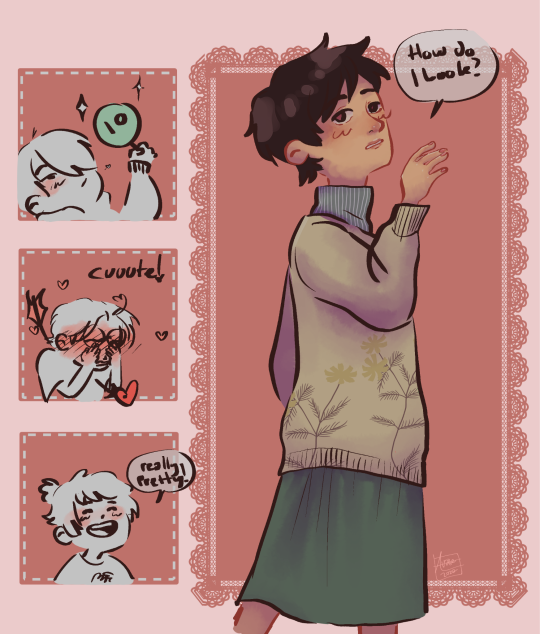
I should have put him in something more colorful but eh 🤷♂️
40 notes
·
View notes
Photo

Started watching the weird Kappa show, and I really like these cops XD
4K notes
·
View notes
Text
Probably what keeps RGU, if not other Ikuhara works, from facing the same level of scrutiny as all the other cartoons ppl take too seriously, is that the whole thing is so ironic and performative. It’s at a remove for being so self-reflexive and meta. But like. Sure it’s “critical” of what it depicts, whatever that means, but it still depicts it, and often part of the appeal is the “problematic” content.
Just sticking to RGU as an example, I’ve run into fans who say that the iconic sword-drawing out scenes are not supposed to be enjoyed, making art based off those scenes is problematic, etc. Basically the idea is that because the show “demonstrates how things that look beautiful and appealing can be destructive,” the audience therefore has to stop having their natural reaction to the sequences.
But the aesthetic level and erotic level have to be kept separate from this kind of moral judgement. All Ikuhara shows rely on appealing visuals. He doesn’t want to make animation that isn’t beautiful. No matter the subject matter, because it’s what he wants, and because he knows it gets audience attention. Instead of coming up with all these intellectual strictures of how you’re “supposed” to approach RGU, people should rely more on how its visuals create tone, mood, affect, what is being communicated on more primal erotic levels, and how the visual appeal of the imagery layers on top of the plot, dialogue, and characters. For instance, there certainly are times when the sword pulling out imagery is both beautiful and horrible, simultaneously.
A majority of western fans do not know how to approach Ikuhara works, or really any work which isn’t conventional and surface level. RGU fans will just ignore most of the work and bring in some outside lens of interpretation. That’s how we end up with people who critique to death both properties they dislike and their interests while acting like RGU is some perfect, unproblematic masterpiece.


I remember seeing these posts years ago before even watching Ikuhara’s other works, and then I watched his other stuff and RGU a million times, and then just sat there like. RGU is exactly the same as everything else Ikuhara has made since. Sure YKA and Sarazanmai could be called more raunchy, but as far as the handling of problematic content, there really was not much difference between them. It’s so interesting how arbitrary a lot of this is. Like, bc of RGU’s reputation and the fact that most fans watched it before people got crazy hyper-analytic of media, everyone collectively pretends it passes their moral standards for media when it does the same things they call problematic in other works. Yeah there’s a lot of sexual imagery in YKA, but it’s more shocking in concept than titillating. I mean there isn’t much porn of it aside from random straight dudes wanting to pound Lulu—it’s just too cute. But RGU is an entire show of erotic depictions of characters exclusively under 18 years of age. LOL. But I guess since it’s “critiquing” sexualization of minors, it’s okay.
Saw someone freaking out bc RGU “lost to an orientalist show” and it’s like oh yes, RGU is a woke masterpiece in comparison
2 notes
·
View notes
Text

good morning, dishu!!
63 notes
·
View notes
Text
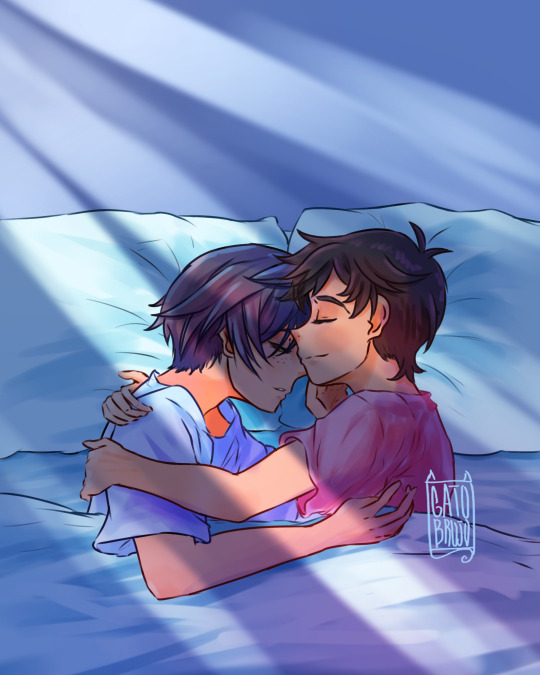
"My best mornings are the ones I wake up next to you"
Pleas don't repost
#kazutoi#toikazu#sarazanmai#kazuki x toi#kazuki yasaka#yasaka kazuki#toi kuji#kuji toi#さらざんまい#i love this couple#cute couple#i ship these two so hard#i ship it#Draw#Drawing#Fanart#Fan art#digital drawing#digital painting#digital art#digital portrait#i love these two#i love them
126 notes
·
View notes
Photo


スタンドバイミー / the peggies
#Illustration#song#sarazanmai#the peggies#kappa#スタンドバイミー#fan art#kunihiko ikuhara#Fanart#さらざんまい#ONEEEEEGAI#ink
1K notes
·
View notes
Photo

Today’s preview of the Sarazanmai Anthology gives us a peak at Yamamoto Kotetsuko’s manga titled “ さらざんまいの3コマ " which translates to “3-Panel Sarazanmai”.
Only 3 more days until the release!!!
#sarazanmai#sarazanmai anthology#minna de sarazanmai#yamamoto kotetsuko#official art#niiboshi reo#akutsu mabu#sarazanmai nonsense#i'm not a huge fan of 4koma or 3koma but it should be funny at least#and something that fits the anthology and balances things out
31 notes
·
View notes
Photo

i want to connect but i’m too busy swim
24 notes
·
View notes
